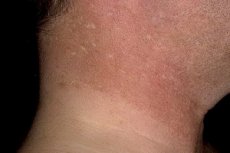Medical expert of the article
New publications
Poikiloderma
Last reviewed: 29.06.2025

All iLive content is medically reviewed or fact checked to ensure as much factual accuracy as possible.
We have strict sourcing guidelines and only link to reputable media sites, academic research institutions and, whenever possible, medically peer reviewed studies. Note that the numbers in parentheses ([1], [2], etc.) are clickable links to these studies.
If you feel that any of our content is inaccurate, out-of-date, or otherwise questionable, please select it and press Ctrl + Enter.

Poikiloderma is a medical term that describes a skin condition characterized by heterogeneity in skin color and texture. This condition can include various skin changes such as spots, redness, pallor, pigmentary irregularities, and texture changes.
Causes of the poochyloderma
Poikiloderma is a skin condition characterized by heterogeneity in skin color and texture. Its causes can be varied and include:
- Sun exposure: It is common to develop papoikiloderma from sun exposure. Ultraviolet rays can damage the skin and promote pigmentation and other changes in the skin.
- Hormonal changes: Some hormonal changes can affect skin pigmentation and contribute to the development of papoikiloderma. For example, pregnancy and taking oral contraceptives can affect the skin.
- Genetic factors: Some people may have a genetic predisposition to develop papoikiloderma.
- Vascular disorders: Dilation or damage to the capillaries of the skin may contribute to the development of papoikiloderma.
- Age: As we age, skin can become less firm and more prone to texture changes and pigmentation.
- Burns and Injuries: Burns and skin injuries can also lead to changes in skin texture and pigmentation.
- Other factors: External agents, such as chemicals and allergic reactions, as well as a number of skin diseases can cause papoikiloderma.
Poikiloderma can appear on different areas of the body and can include a variety of skin changes including spots, redness, pallor, and pigmentation abnormalities.
Symptoms of the poochyloderma
Here are some of the most common symptoms associated with poochyloderma:
- Pigmentation changes: Poikiloderma may include pigmentation changes in the skin such as spots, redness, and areas of altered pigmentation.
- Uneven texture: Skin may have an uneven texture, including roughness, wrinkles, or changes in topography.
- Dilated blood vessels: In some cases, papoikiloderma may be accompanied by dilation of the skin's blood vessels, which can lead to the appearance of couperosis (dilated capillaries).
- Edema: There may be swelling of areas of skin affected by papoikiloderma.
- Dryness and irritation: Your skin may be drier and more sensitive, which can cause itching or irritation.
- Increased sunburn: The skin may be more sensitive to sunlight, which can lead to more frequent sunburns and worsening of symptoms.
Symptoms can be of varying severity and vary according to individual patient characteristics and skin conditions.
Diagnostics of the poochyloderma
Diagnosing papoikiloderma involves a physical examination, a history (talking to the patient about their medical and family history), and sometimes additional laboratory and instrumental tests. Here are common steps that may be included in the process of diagnosing papoikiloderma:
- Physical Exam: A dermatologist may closely examine the area of skin affected by the changes and assess its color, texture, pigmentation, and other characteristics. The doctor may also perform a general physical examination to rule out other skin or systemic diseases.
- Medical history: Your doctor will ask you questions about your symptoms, how long you have had them, factors that may have triggered the symptoms, and your medical and family history.
- Additional tests: In some cases, your doctor may order additional laboratory or instrumental tests to confirm the diagnosis or rule out other conditions. These tests may include a skin biopsy (taking a tissue sample for laboratory analysis), blood tests, some additional educational methods such as dermatoscopy or ultrasound.
- Differential Diagnosis: A dermatologist should rule out other conditions that may mimic the symptoms of papoikiloderma, such as rosacea, pigmentary disorders, vascular skin disease, and other dermatologic conditions.
Once all the necessary tests have been done, the doctor can diagnose the condition and tell you about possible treatments and skin care options.
Who to contact?
Treatment of the poochyloderma
Treatment of papoikiloderma depends on its type, cause, and severity of symptoms. The disease can be caused by a variety of factors, and its treatment can involve a variety of methods. Here are some of the possible treatments for papoikiloderma:
- Sun Protection: Poikiloderma is often aggravated by sun exposure, so it is important to use sunscreen with a high SPF and limit your skin's exposure to the sun.
- Cosmetic procedures: In some cases, cosmetic procedures can help improve the appearance of the skin. These treatments may include laser therapy, chemical peels, microdermabrasion, and injections.
- Skin Care: Proper skin care can help improve the appearance and condition of your skin. This includes using moisturizers, mild cleansers, and other products recommended by your dermatologist.
- Treatment of vascular changes: If papoikiloderma is accompanied by vascular changes, the doctor may recommend special procedures to improve them, such as laser or injection therapy.
- Medication: In some cases, your doctor may prescribe medications, such as topical steroids or drugs that affect skin pigmentation, to improve symptoms.
- Diet and vitamin therapy: Depending on the cause of papoikiloderma, your doctor may recommend changes in your diet or taking vitamins that may be beneficial to your skin.
Treatment should be individualized and tailored to each patient's specific needs. It is important to see a dermatologist to evaluate and develop a treatment plan that is best for you.

